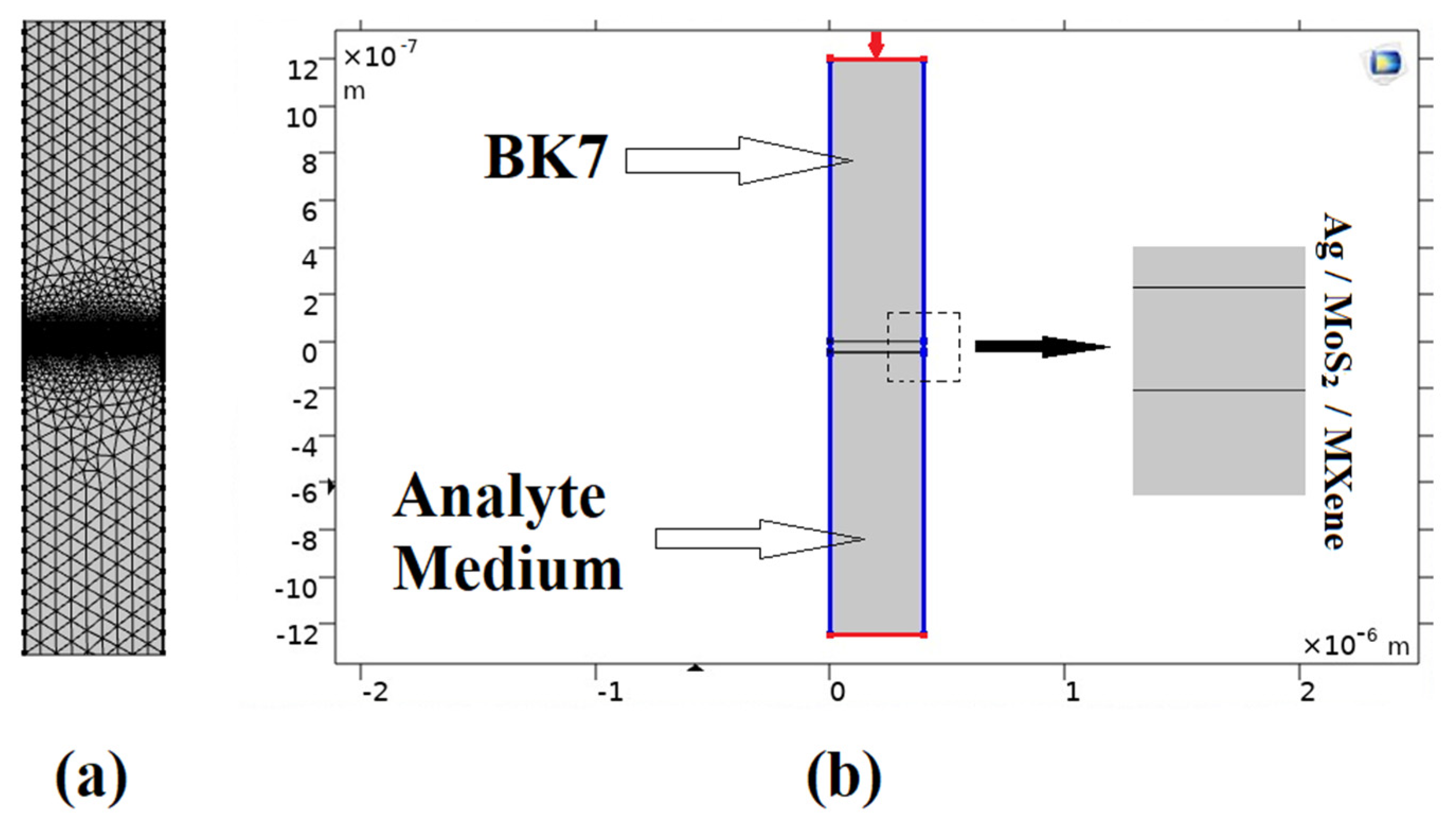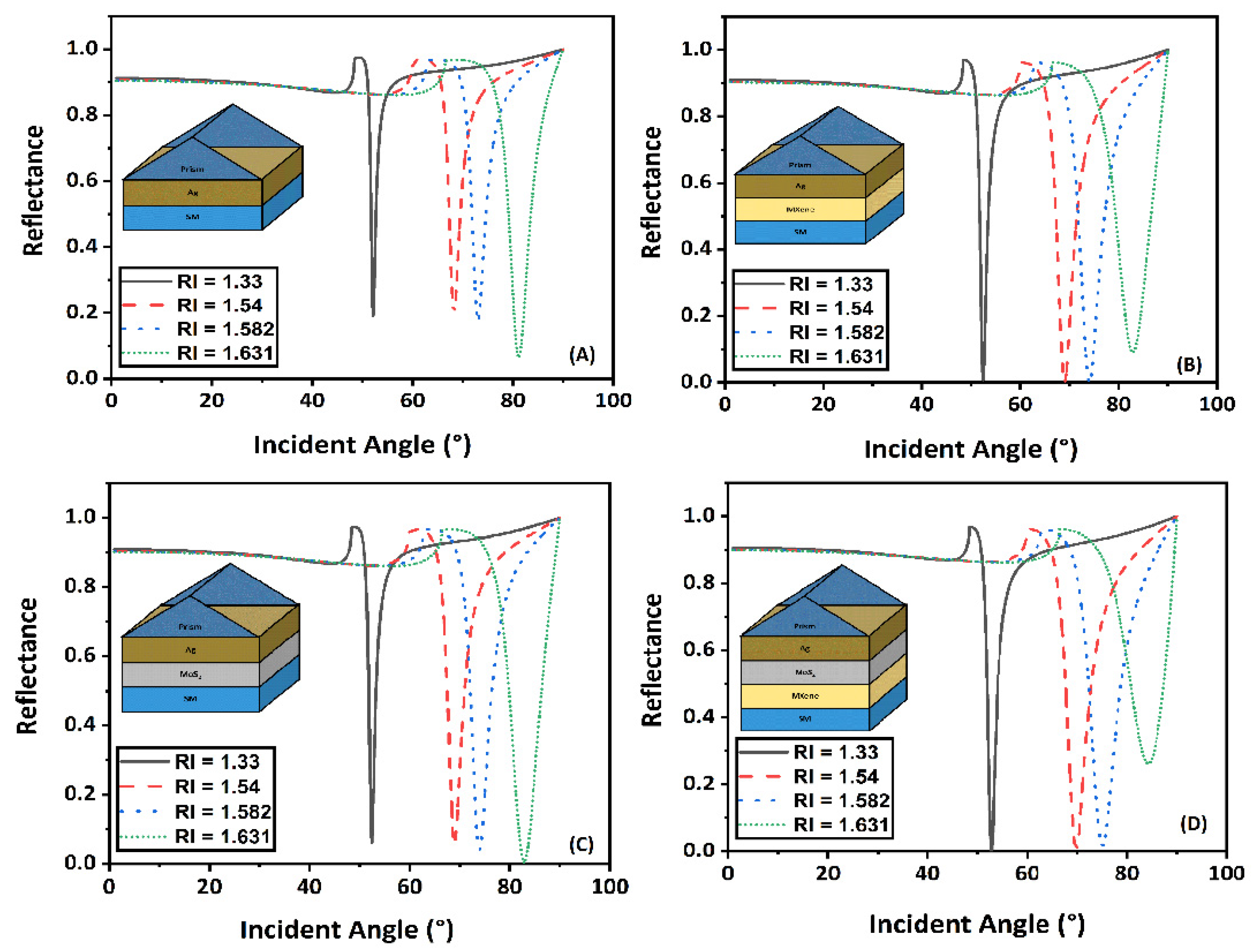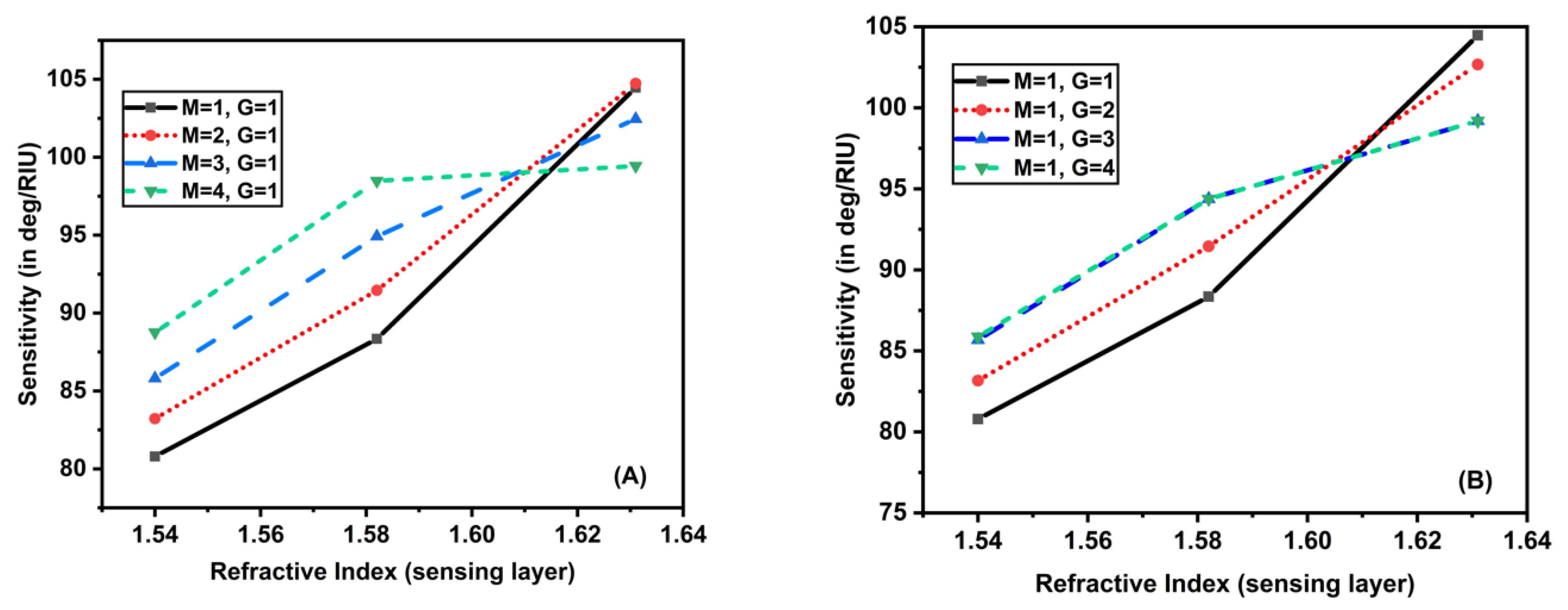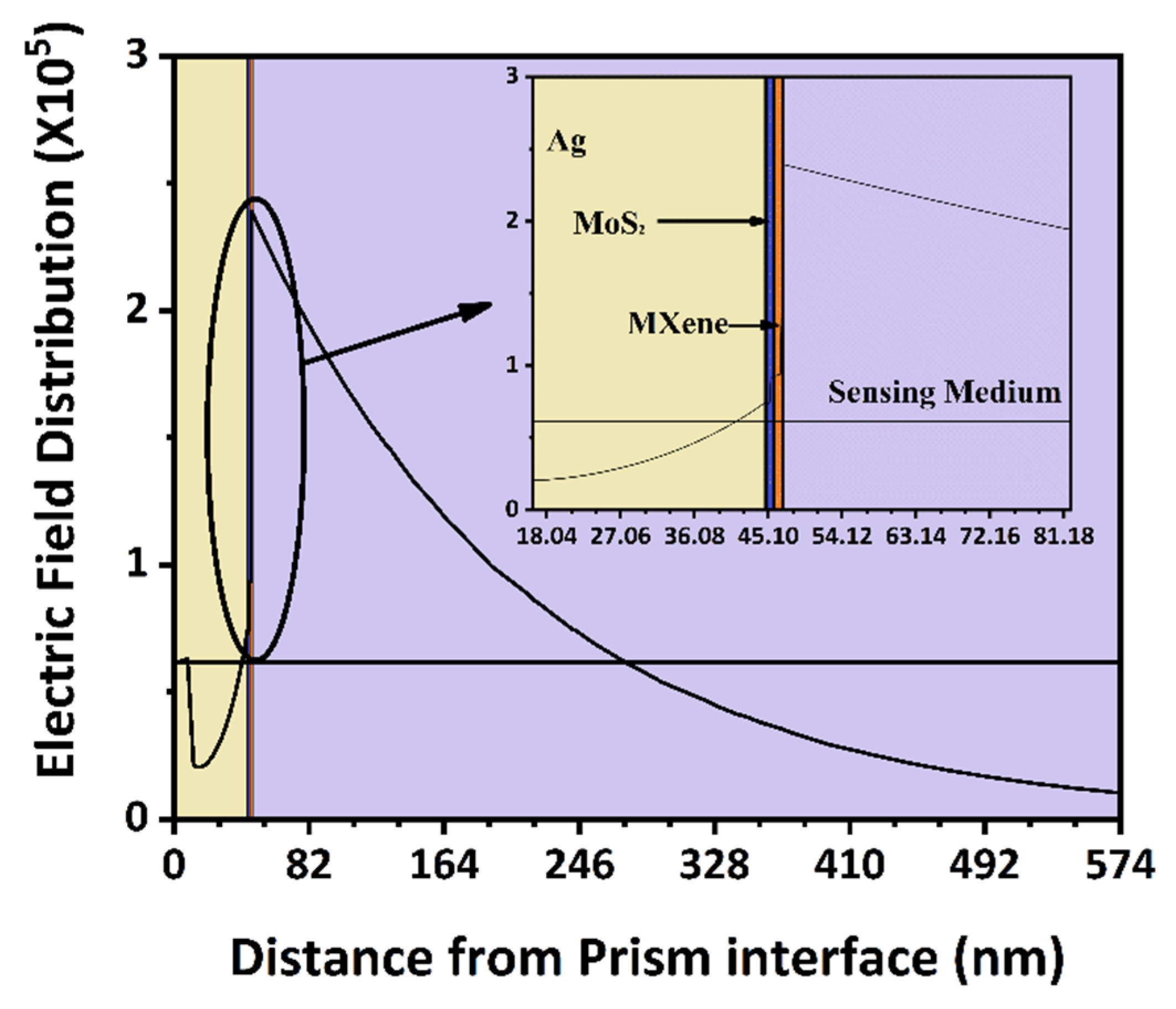Human Teeth Disease Detection Using Refractive Index Based Surface Plasmon Resonance Biosensor
Abstract
1. Introduction
2. Proposed Structure and Design Methodology
2.1. Numerical Modelling
2.2. Field Distribution Computation
3. Results and Discussion
3.1. Detection
3.2. Electric Field Analysis
4. Conclusions
Author Contributions
Funding
Data Availability Statement
Conflicts of Interest
References
- Akib, T.; Mou, S.; Rahman, M.; Rana, M.; Islam, R.; Mehedi, I.; Mahmud, M.; Kouzani, A. Design and numerical analysis of a graphene-coated SPR biosensor for rapid detection of the novel coronavirus. Sensors 2021, 21, 3491. [Google Scholar] [CrossRef] [PubMed]
- Gao, Y.; Xin, Z.; Zeng, B.; Gan, Q.; Cheng, X.; Bartoli, F.J. Plasmonic interferometric sensor arrays for high-performance label-free biomolecular detection. Lab Chip 2013, 13, 4755–4764. [Google Scholar] [CrossRef] [PubMed]
- Chabot, V.; Miron, Y.; Grandbois, M.; Charette, P.G. Long range surface plasmon resonance for increased sensitivity in living cell biosensing through greater probing depth. Sens. Actuators B Chem. 2012, 174, 94–101. [Google Scholar] [CrossRef]
- Yang, X.; Yuan, Y.; Dai, Z.; Liu, F.; Huang, J. Optical property and adsorption isotherm models of glucose sensitive membrane based on prism SPR sensor. Sens. Actuators B Chem. 2016, 237, 150–158. [Google Scholar] [CrossRef]
- Hou, D.; Ji, X.; Luan, N.; Song, L.; Hu, Y.; Luo, M.; He, J.; Bai, Z.; Bai, Z.; Liu, J. Surface Plasmon Resonance Sensor Based on Double-Sided Polished Microstructured Optical Fiber with Hollow Core. IEEE Photonic J. 2021, 13, 1–8. [Google Scholar] [CrossRef]
- Sahu, S.; Ali, J.; Yupapin, P.P.; Singh, G. Porous Silicon Based Bragg-Grating Resonator for Refractive Index Biosensor. Photonic Sens. 2018, 8, 248–254. [Google Scholar] [CrossRef]
- Homola, J. Surface plasmon resonance sensors for detection of chemical and biological species. Chem. Rev. 2008, 108, 462–493. [Google Scholar] [CrossRef]
- Karki, B.; Pal, A.; Singh, Y.; Sharma, S. Sensitivity enhancement of surface plasmon resonance sensor using 2D material barium titanate and black phosphorus over the bimetallic layer of Au, Ag, and Cu. Opt. Commun. 2021, 508, 127616. [Google Scholar] [CrossRef]
- Kretschmann, E.; Raether, H. Radiative decay of non-radiative surface plasmons by light. Z. Nat. 1968, 23, 2135–2136. [Google Scholar]
- Karki, B.; Uniyal, A.; Sharma, T.; Pal, A.; Srivastava, V. Indium phosphide and black phosphorus employed surface plasmon resonance sensor for formalin detection: Numerical analysis. Opt. Eng. 2022, 61, 017101. [Google Scholar] [CrossRef]
- Kashyap, R.; Chakraborty, S.; Zeng, S.; Swarnakar, S.; Kaur, S.; Doley, R.; Mondal, B. Enhanced biosensing activity of bimetallic surface plasmon resonance sensor. Photonics 2019, 6, 108. [Google Scholar] [CrossRef]
- Uniyal, A.; Chauhan, B.; Pal, A.; Singh, Y. Surface plasmon biosensor based on Bi2Te3 antimonene heterostructure for the detection of cancer cells. Appl. Opt. 2022, 61, 3711–3719. [Google Scholar] [CrossRef]
- Deng, Y.; Cao, G.; Yang, H.; Zhou, X.; Wu, Y. Dynamic Control of Double Plasmon-Induced Transparencies in Aperture-Coupled Waveguide-Cavity System. Plasmonics 2017, 13, 345–352. [Google Scholar] [CrossRef]
- Deng, Y.; Cao, G.; Wu, Y.; Zhou, X.; Liao, W. Theoretical Description of Dynamic Transmission Characteristics in MDM Waveguide Aperture-Side-Coupled with Ring Cavity. Plasmonics 2015, 10, 1537–1543. [Google Scholar] [CrossRef]
- Datta, S.; Modak, B.; Chaki, N. A Complete Review on Dental Carious Lesion Detection Methods and its Challenges. Acta Sci. Dent. Sci. 2019, 3, 74–81. [Google Scholar] [CrossRef]
- Wu, L.; Jia, Y.; Jiang, L.; Guo, J.; Dai, X.; Xiang, Y.; Fan, D. Sensitivity Improved SPR Biosensor Based on the MoS2/Graphene–Aluminum Hybrid Structure. J. Light Technol. 2016, 35, 82–87. [Google Scholar] [CrossRef]
- Kim, N.-H.; Choi, M.; Kim, T.W.; Choi, W.; Park, S.Y.; Byun, K.M. Sensitivity and stability enhancement of surface plasmon resonance biosensors based on a large-area Ag/MoS2 substrate. Sensors 2019, 19, 1894. [Google Scholar] [CrossRef]
- Lin, Z.; Jiang, L.; Wu, L.; Guo, J.; Dai, X.; Xiang, Y.; Fan, D. Tuning and Sensitivity Enhancement of Surface Plasmon Resonance Biosensor with Graphene Covered Au-MoS 2-Au Films. IEEE Photonic J. 2016, 8, 1–8. [Google Scholar] [CrossRef]
- Kumar, A.; Yadav, A.K.; Kushwaha, A.S.; Srivastava, S. A comparative study among WS2, MoS2 and graphene based surface plasmon resonance (SPR) sensor. Sens. Actuators Rep. 2020, 2, 100015. [Google Scholar] [CrossRef]
- Karki, B.; Uniyal, A.; Chauhan, B.; Pal, A. Sensitivity enhancement of a graphene, zinc sulfide-based surface plasmon resonance biosensor with an Ag metal configuration in the visible region. J. Comput. Electron. 2022, 21, 445–452. [Google Scholar] [CrossRef]
- Nurrohman, D.T.; Chiu, N.-F. Surface Plasmon Resonance Biosensor Performance Analysis on 2D Material Based on Graphene and Transition Metal Dichalcogenides. ECS J. Solid State Sci. Technol. 2020, 9, 115023. [Google Scholar] [CrossRef]
- Pal, A.; Jha, A. A theoretical analysis on sensitivity improvement of an SPR refractive index sensor with graphene and barium titanate nanosheets. Optik 2021, 231, 166378. [Google Scholar] [CrossRef]
- Zhao, Y.; Gan, S.; Zhang, G.; Dai, X. High sensitivity refractive index sensor based on surface plasmon resonance with topological insulator. Results Phys. 2019, 14, 102477. [Google Scholar] [CrossRef]
- Sathya, N.; Karki, B.; Rane, K.P.; Jha, A.; Pal, A. Tuning and Sensitivity Improvement of Bi-Metallic Structure-Based Surface Plasmon Resonance Biosensor with 2-D ε-Tin Selenide Nanosheets. Plasmonics 2022, 17, 1001–1008. [Google Scholar] [CrossRef]
- Srivastava, T.; Jha, R. Black Phosphorus: A New Platform for Gaseous Sensing Based on Surface Plasmon Resonance. IEEE Photonic Technol. Lett. 2018, 30, 319–322. [Google Scholar] [CrossRef]
- Singh, Y.; Raghuwanshi, S.K. Sensitivity Enhancement of the Surface Plasmon Resonance Gas Sensor with Black Phosphorus. IEEE Sens. Lett. 2019, 3, 1–4. [Google Scholar] [CrossRef]
- Wu, L.; Guo, J.; Wang, Q.; Lu, S.; Dai, X.; Xiang, Y.; Fan, D. Sensitivity enhancement by using few-layer black phosphorus-graphene/TMDCs heterostructure in surface plasmon resonance biochemical sensor. Sens. Actuators B Chem. 2017, 249, 542–548. [Google Scholar] [CrossRef]
- Bijalwan, A.; Rastogi, V. Gold–aluminum-based surface plasmon resonance sensor with a high quality factor and figure of merit for the detection of hemoglobin. Appl. Opt. 2018, 57, 9230–9237. [Google Scholar] [CrossRef]
- Karki, B.; Sharma, S.; Singh, Y.; Pal, A. Sensitivity Enhancement of Surface Plasmon Resonance Biosensor with 2-D Franckeite Nanosheets. Plasmonics 2021, 17, 71–78. [Google Scholar] [CrossRef]
- Liu, L.; Zhang, X.; Zhu, Q.; Li, K.; Lu, Y.; Zhou, X.; Guo, T. Ultrasensitive detection of endocrine disruptors via superfine plasmonic spectral combs. Light Sci. Appl. 2021, 10, 181. [Google Scholar] [CrossRef]
- Sun, J.; Du, H.; Chen, Z.; Wang, L.; Shen, G. MXene quantum dot within natural 3D watermelon peel matrix for biocompatible flexible sensing platform. Nano Res. 2021, 15, 3653–3659. [Google Scholar] [CrossRef]
- Du, X.; Tian, W.; Pan, J.; Hui, B.; Sun, J.; Zhang, K.; Xia, Y. Piezo-phototronic effect promoted carrier separation in coaxial p-n junctions for self-powered photodetector. Nano Energy 2021, 92, 106694. [Google Scholar] [CrossRef]
- Liu, W.; Zheng, Y.; Wang, Z.; Wang, Z.; Yang, J.; Chen, M.; Qi, M.; Rehman, S.U.; Shum, P.P.; Zhu, L.; et al. Ultrasensitive Exhaled Breath Sensors Based on Anti-Resonant Hollow Core Fiber with In Situ Grown ZnO-Bi2O3 Nanosheets. Adv. Mater. Interfaces 2021, 8, 2001978. [Google Scholar] [CrossRef]
- Shangguan, Q.; Chen, Z.; Yang, H.; Cheng, S.; Yang, W.; Yi, Z.; Wu, X.; Wang, S.; Yi, Y.; Wu, P. Design of Ultra-Narrow Band Graphene Refractive Index Sensor. Sensors 2022, 22, 6483. [Google Scholar] [CrossRef]
- Bu, W.; Wu, Z.; Shum, P.P.; Shao, X.; Pu, J. Sensitivity Enhanced Refractive Index Fiber Sensor Based on Long-Range Surface Plasmon Resonance in SiO2-Au-TiO2 Heterostructure. Photonics 2021, 8, 379. [Google Scholar] [CrossRef]
- Naguib, M.; Mochalin, V.N.; Barsoum, M.W.; Gogotsi, Y. 25th anniversary article: MXenes: A new family of two-dimensional materials. Adv. Energy Mater. 2014, 26, 992–1005. [Google Scholar] [CrossRef]
- Pandey, P.S.; Singh, Y.; Raghuwanshi, S.K. Theoretical analysis of the LRSPR sensor with Enhance FOM for Low Refractive Index Detection using MXene and Fluorinated Graphene. IEEE Sens. J. 2021, 21, 23979–23986. [Google Scholar] [CrossRef]
- Anasori, B.; Lukatskaya, M.R.; Gogotsi, Y. 2D metal carbides and nitrides (MXenes) for energy storage. Nat. Rev. Mater. 2017, 2, 16098. [Google Scholar] [CrossRef]
- Miranda, A.; Halim, J.; Lorke, A.; Barsoum, M.W. Rendering Ti3C2Tx (MXene) monolayers visible. Mater. Res. Lett. 2017, 5, 322–328. [Google Scholar] [CrossRef]
- Uniyal, A.; Chauhan, B.; Pal, A.; Srivastava, V. InP and graphene employed surface plasmon resonance sensor for measurement of sucrose concentration: A numerical approach. Opt. Eng. 2022, 61, 057103. [Google Scholar] [CrossRef]
- Johnson, P.B.; Christy, R.W. Optical Constant of the Nobel Metals. Phys. Rev. B 1972, 6, 4370–4379. [Google Scholar] [CrossRef]
- Karki, B.; Trabelsi, Y.; Uniyal, A.; Pal, A. Zinc sulfide, silicon dioxide, and black phosphorus based ultra-sensitive surface plasmon biosensor. Opt. Quantum Electron. 2022, 54, 107. [Google Scholar] [CrossRef]
- Liu, L.; Wang, M.; Jiao, L.; Wu, T.; Xia, F.; Liu, M.; Kong, W.; Dong, L.; Yun, M. Sensitivity enhancement of a graphene–barium titanate-based surface plasmon resonance biosensor with an Ag–Au bimetallic structure in the visible region. JOSA B 2019, 36, 1108–1116. [Google Scholar] [CrossRef]
- Singh, Y.; Paswan, M.K.; Raghuwanshi, S.K. Sensitivity Enhancement of SPR Sensor with the Black Phosphorus and Graphene with Bi-layer of Gold for Chemical Sensing. Plasmonics 2021, 16, 1781–1790. [Google Scholar] [CrossRef]
- Gwon, H.R.; Lee, S.H. Spectral and angular responses of surface plasmon resonance based on the kretschmann prism configuration. Mater. Trans. 2010, 51, 1150–1155. [Google Scholar] [CrossRef]
- Srivastava, S.K.; Verma, R.; Gupta, B.D. Theoretical modeling of a self-referenced dual mode SPR sensor utilizing indium tin oxide film. Opt. Commun. 2016, 369, 131–137. [Google Scholar] [CrossRef]
- Mostufa, S.; Paul, A.K.; Chakrabarti, K. Detection of hemoglobin in blood and urine glucose level samples using a graphene-coated SPR based biosensor. OSA Contin. 2021, 4, 2164–2176. [Google Scholar] [CrossRef]
- Hossain, B.; Rana, M.; Abdulrazak, L.F.; Mitra, S.; Rahman, M. Design and analysis of graphene–MoS2 hybrid layer based SPR biosensor with TiO2–SiO2 nano film for formalin detection: Numerical approach. Opt. Quantum Electron. 2019, 51, 195. [Google Scholar] [CrossRef]
- Rahman, M.; Rana, M.; Rahman, S.; Anower, M.; Mollah, A.; Paul, A.K. Sensitivity enhancement of SPR biosensors employing heterostructure of PtSe2 and 2D materials. Opt. Mater. 2020, 107, 110123. [Google Scholar] [CrossRef]
- Mostufa, S.; Akib, T.B.A.; Rana, M.; Islam, R. Highly Sensitive TiO2/Au/Graphene Layer-Based Surface Plasmon Resonance Biosensor for Cancer Detection. Biosensors 2022, 12, 603. [Google Scholar] [CrossRef]
- Basak, C.; Hosain, K.; Sazzad, A.A. Design and Simulation of a High Sensitive Surface Plasmon Resonance Biosensor for Detection of Biomolecules. Sens. Imaging 2019, 21, 2. [Google Scholar] [CrossRef]
- Shalabney, A.; Abdulhalim, I. Electromagnetic fields distribution in multilayer thin film structures and the origin of sensitivity enhancement in surface plasmon resonance sensors. Sens. Actuators A Phys. 2010, 159, 24–32. [Google Scholar] [CrossRef]
- Verma, A.; Prakash, A.; Tripathi, R. Performance analysis of graphene based surface plasmon resonance biosensors for detection of pseudomonas-like bacteria. Opt. Quantum Electron. 2014, 47, 1197–1205. [Google Scholar] [CrossRef]
- Xia, L.; Yin, S.; Gao, H.; Deng, Q.; Du, C. Sensitivity Enhancement for Surface Plasmon Resonance Imaging Biosensor by Utilizing Gold–Silver Bimetallic Film Configuration. Plasmonics 2011, 6, 245–250. [Google Scholar] [CrossRef]
- Rouf, H.K.; Haque, T. Performance enhancement of Ag-Au bimetallic surface plasmon resonance biosensor using InP. Prog. Electromagn. Res. M 2018, 76, 31–42. [Google Scholar] [CrossRef]
- Rahman, M.S.; Anower, S.; Hasan, R.; Hossain, B.; Haque, I. Design and numerical analysis of highly sensitive Au-MoS2-graphene based hybrid surface plasmon resonance biosensor. Opt. Commun. 2017, 396, 36–43. [Google Scholar] [CrossRef]
- Ramanavicius, S.; Ramanavicius, A. Progress and Insights in the Application of MXenes as New 2D Nano-Materials Suitable for Biosensors and Biofuel Cell Design. Int. J. Mol. Sci. 2020, 21, 9224. [Google Scholar] [CrossRef]
- Tabrizi, M.A.; Ferre-Borrull, J.; Marsal, L.F. Advances in Optical Biosensors and Sensors Using Nanoporous Anodic Alumina. Sensors 2020, 20, 5068. [Google Scholar] [CrossRef]
- Li, K.; Zhou, W.; Zeng, S. Optical Micro/Nanofiber-Based Localized Surface Plasmon Resonance Biosensors: Fiber Diameter Dependence. Sensors 2018, 18, 3295. [Google Scholar] [CrossRef]








| Detection Methods | Classification | Advantages | Disadvantages |
|---|---|---|---|
| Diagnodent | Point techniques (dental caries) | Trouble-free and rapid test, accurate, flexible, and mobile operated | In order to give a treatment plan, the laser device Diagnodent cannot determine the degree of demineralization. |
| ECM | Helps dentists to monitor, demineralize, and treat patients’ root caries lesions, as well as assists in a thorough examination of the tooth’s structural details. | Its performance relies upon a tooth’s temperature, tissue width, hydration, and surface area of the material. | |
| FOTI | Light property technique | Compact and battery-operated devices, observations of cusp fractures and cracked teeth, and diagnoses of early carious lesion | Moderate sensitivity (85%) and specificity are around 99%, detects only the occlusal caries on premolars and molars teeth. |
| DIFOTI | Diagnosis in real-time, greater sensitivity for early lesions detection. | Its camera is very heavy. Fitting inside a younger person’s mouth is a complex process. | |
| QLF | Light emitting devices | User friendly, easily fits inside children’s mouths, etc. | The light source used is a laser, size is bulky. |
| Digital Radiographs | Radio graphs | Real time analysis, rapid method so it saves time and is also quite cheaper. | Can be dangerous to humans because it uses ionizing radiation, width, and rigidity. |
| RI | Layers | Min. Reflectance | Δθ (deg) |
|---|---|---|---|
| 1.33 | 0.19109 | ||
| 1.54 | 0.19935 | 16.104 | |
| 1.582 | 0.17701 | 20.896 | |
| 1.631 | 0.06476 | 28.988 | |
| 1.33 | 0.19109 | ||
| 1.54 | 0.19935 | 16.534 | |
| 1.582 | 0.17701 | 21.566 | |
| 1.631 | 0.06476 | 30.382 | |
| 1.33 | 0.06071 | ||
| 1.54 | 0.05924 | 16.498 | |
| 1.582 | 0.04069 | 21.521 | |
| 1.631 | 0.00521 | 30.473 | |
| 1.33 | 0.000711776 | ||
| 1.54 | 0.00488 | 16.967 | |
| 1.582 | 0.01825 | 22.263 | |
| 1.631 | 0.26247 | 31.446 |
| RI | Sensitivity (M = 1, G = 1) | Sensitivity (M = 2, G = 1) | Sensitivity (M = 3, G = 1) | Sensitivity (M = 4, G = 1) |
|---|---|---|---|---|
| 1.33 | - | - | - | - |
| 1.54 | 80.795 deg/RIU | 83.219 deg/RIU | 85.814 deg/RIU | 88.757 deg/RIU |
| 1.582 | 88.345 deg/RIU | 91.460 deg/RIU | 94.920 deg/RIU | 98.484 deg/RIU |
| 1.631 | 104.471 deg/RIU | 104.744 deg/RIU | 102.458 deg/RIU | 99.441 deg/RIU |
| RI | Sensitivity (M = 1, G = 1) | Sensitivity (M = 1, G = 2) | Sensitivity (M = 1, G = 3) | Sensitivity (M = 1, G = 4) |
|---|---|---|---|---|
| 1.33 | - | - | - | - |
| 1.54 | 80.795 deg/RIU | 83.166 deg/RIU | 85.680 deg/RIU | 85.880 deg/RIU |
| 1.582 | 88.345 deg/RIU | 91.452 deg/RIU | 94.380 deg/RIU | 94.380 deg/RIU |
| 1.631 | 104.471 deg/RIU | 102.671 deg/RIU | 99.189 deg/RIU | 99.196 deg/RIU |
| Concentration Added (nM) | Minimum Reflectance (Rmin) | Incident Angle |
|---|---|---|
| 0 nM, immobilizer probe | 0.000712 | 52.778 deg |
| 25 nM, detectable target | 0.000717 | 53.241 deg |
| 50 nM detectable target | 0.000715 | 53.009 deg |
| 100 nM, detectable target | 0.000713 | 52.893 deg |
| 200 nM, detectable target | 0.000712 | 52.835 deg |
| References | Design | Sensitivity |
|---|---|---|
| Present study | Prism/Ag/MoS2/MXene | 104.744 deg/RIU |
| [53] | Prism/Au/graphene/Affinity layer | 33.98 deg/RIU |
| [54] | Prism/Ag/Au | 54.84 deg/RIU |
| [55] | Prism/Airgap/Ti/Ag/Au/InP | 70.90 deg/RIU |
| [56] | Prism/Au/graphene/MoS2 | 89.29 deg/RIU |
Publisher’s Note: MDPI stays neutral with regard to jurisdictional claims in published maps and institutional affiliations. |
© 2022 by the authors. Licensee MDPI, Basel, Switzerland. This article is an open access article distributed under the terms and conditions of the Creative Commons Attribution (CC BY) license (https://creativecommons.org/licenses/by/4.0/).
Share and Cite
Alam, M.K.; Dhasarathan, V.; Natesan, A.; Nambi, R.; Zaman, M.U.; Ganji, K.K.; Basri, R.; Munisekhar, M.S.; Nagarajappa, A.K.; Abutayyem, H. Human Teeth Disease Detection Using Refractive Index Based Surface Plasmon Resonance Biosensor. Coatings 2022, 12, 1398. https://doi.org/10.3390/coatings12101398
Alam MK, Dhasarathan V, Natesan A, Nambi R, Zaman MU, Ganji KK, Basri R, Munisekhar MS, Nagarajappa AK, Abutayyem H. Human Teeth Disease Detection Using Refractive Index Based Surface Plasmon Resonance Biosensor. Coatings. 2022; 12(10):1398. https://doi.org/10.3390/coatings12101398
Chicago/Turabian StyleAlam, Mohammad Khursheed, Vigneswaran Dhasarathan, Ayyanar Natesan, Ramanujam Nambi, Mahmud Uz Zaman, Kiran Kumar Ganji, Rehana Basri, Manay Srinivas Munisekhar, Anil Kumar Nagarajappa, and Huda Abutayyem. 2022. "Human Teeth Disease Detection Using Refractive Index Based Surface Plasmon Resonance Biosensor" Coatings 12, no. 10: 1398. https://doi.org/10.3390/coatings12101398
APA StyleAlam, M. K., Dhasarathan, V., Natesan, A., Nambi, R., Zaman, M. U., Ganji, K. K., Basri, R., Munisekhar, M. S., Nagarajappa, A. K., & Abutayyem, H. (2022). Human Teeth Disease Detection Using Refractive Index Based Surface Plasmon Resonance Biosensor. Coatings, 12(10), 1398. https://doi.org/10.3390/coatings12101398







